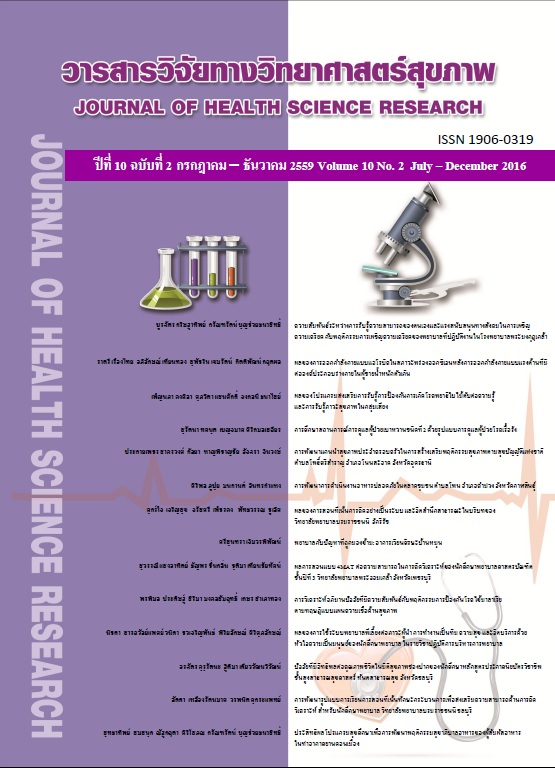ผลของโปรแกรมส่งเสริมการรับรู้การป้องกันการเกิดโรคพยาธิใบไม้ตับต่อความรู้และการรับรู้ภาวะสุขภาพในกลุ่มเสี่ยง
Main Article Content
บทคัดย่อ
การวิจัยครั้งนี้เป็นการวิจัยกึ่งทดลองมีวัตถุประสงค์เพื่อศึกษาผลของโปรแกรมส่งเสริมการรับรู้การป้องกันการเกิดโรคพยาธิใบไม้ตับ ต่อความรู้ และการรับรู้ภาวะสุขภาพในกลุ่มเสี่ยง โดยการประยุกต์ใช้แบบแผนความเชื่อด้านสุขภาพร่วมกับกระบวนการวางแผนแบบมีส่วนร่วมในการจัดกิจกรรม ศึกษาจากกลุ่มตัวอย่าง 74 คน โดยแบ่งเป็นกลุ่มทดลองและกลุ่มเปรียบเทียบกลุ่มละ 37 คน กลุ่มทดลองได้เข้าร่วมกิจกรรมในการป้องกันโรคพยาธิใบไม้ตับ ระยะเวลาดำเนินการ 12 สัปดาห์ เครื่องมือเก็บรวบรวมข้อมูล ประกอบด้วยแบบสอบถาม สถิติที่ใช้ในการวิเคราะห์ข้อมูล ได้แก่ ร้อยละ ค่าเฉลี่ย ส่วนเบี่ยงเบนมาตรฐาน พิสัย และเปรียบเทียบความแตกต่าง โดยใช้ Paired Sample t–test และ Independent t-test กำหนดระดับนัยสำคัญที่ .05
ผลการวิจัย ภายหลังการทดลอง พบว่ากลุ่มทดลองมีคะแนนเฉลี่ยความรู้ การรับรู้โอกาสเสี่ยง การรับรู้ความรุนแรง การรับรู้ประโยชน์และอุปสรรคการป้องกันโรคพยาธิใบไม้ตับมากกว่าก่อนการทดลองและมากกว่ากลุ่มเปรียบเทียบอย่างมีนัยสำคัญทางสถิติที่ .01
จากผลการศึกษาครั้งนี้ สรุปได้ว่าโปรแกรมส่งเสริมการรับรู้การป้องกันการเกิดโรคพยาธิใบไม้ตับ มีผลต่อความรู้ และการรับรู้ภาวะสุขภาพในกลุ่มเสี่ยง โดยผลสำเร็จจากการดำเนินงานตามโปรแกรมครั้งนี้ มีปัจจัยสำคัญ คือ การใช้สื่อที่เข้าใจง่าย โดยใช้วัสดุหาง่ายในพื้นที่ คือ ใบไม้ และมีวิธีการเข้าถึงโดยใช้หมอลำพื้นบ้านเป็นสื่อกลาง ส่งผลให้เกิดความรู้และการรับรู้ในการป้องกันและควบคุมโรคพยาธิใบไม้ตับ
The purpose of this quasi-experimental research was to study the effects of a program to promote the perception to prevent Opisthorchiasis on knowledge and perception of health in the risk group. In the experimental group a 12- week program based-on the conceptual framework of Health Belief Model and participatory planning for prevention of Opisthorchiasis was applied. The control group received conventional treatment. Samples consisted of 74 subjects equally assigned into control and intervention groups. Measures were composed of five questionnaires. The study employed descriptive statistics, Paired sample t–test, and Independent t-test, at significant level .05.
The results showed that at post-test, the mean scores of knowledge, perceived susceptibility, perceived severity, perceived benefit and barriers of prevention were significantly higher than that at pre-test in the experimental group. It was also found that the post-test scores were significantly higher in the experimental group compated to the controls (p < .01).
The results of this study indicate that the program to promote the perception to prevent Opisthorchiasis improved knowledge and perception of health in the risk group. The key of success of the program applied could be from the simple media adapted from local materials and local folk.
Downloads
Article Details
บทความที่ได้รับการตีพิมพ์เป็นลิขสิทธิ์ของวิทยาลัยพยาบาลบรมราชชนนี จังหวัดนนทบุรี
ข้อความที่ปรากฏในบทความแต่ละเรื่องในวารสารวิชาการเล่มนี้เป็นความคิดเห็นส่วนตัวของผู้เขียนแต่ละท่านไม่เกี่ยวข้องกับวิทยาลัยพยาบาลบรมราชชนนี จังหวัดนนทบุรี และคณาจารย์ท่านอื่น ในวิทยาลัยฯ แต่อย่างใด ความรับผิดชอบองค์ประกอบทั้งหมดของบทความแต่ละเรื่องเป็นของผู้เขียนแต่ละท่าน หากมีความผิดพลาดใด ๆ ผู้เขียนแต่ละท่านจะรับผิดชอบบทความของตนเองแต่ผู้เดียว


